Scuba Diving in Punta Cana 2025. What fish are in Punta Cana? Part 1
Punta Cana is a resort town within the Punta Cana-Bávaro-Veron-Macao municipal district, in the municipality of Higüey, in La Altagracia Province, the easternmost province of the Dominican Republic. The area has beaches and balnearios which face both the Caribbean Sea and the Atlantic Ocean, and it is a tourist destination. Due to its location at the Caribbean Sea, diving is one of the tourist activities. The marine area surrounding Punta Cana was declared a marine reserve in 2012 [Source].
Yellowtail Snapper (Ocyurus Chrysurus)
The yellowtail snapper (Ocyurus chrysurus) is an abundant species of snapper native to the western Atlantic Ocean including the Gulf of Mexico and the Caribbean Sea. Although they have been found as far north as Massachusetts, their normal range is along Florida south to the West Indies and Brazil. This species is mostly found around coral reefs, but may be found in other habitats.

Yellowtail Snapper. Fhoto by Transity wikipedia.org (CC BY-SA 3.0)
They occur at depths of from near the surface to 180 metres, though mostly between 10 and 70 m. This species can reach a length of 86.3 cm, though most do not exceed 40 cm. The greatest weight recorded for this species is 4.1 kg. It is a commercially important species and has been farmed. It is sought as a game fish by recreational anglers and is a popular species for display in public aquaria. This species is the only known member of its genus.
In certain reefs, most notably in the Florida Keys, this beautifully colored fish is commonly spotted among divers and snorkelers. Yellowtails feed on shrimp, crabs, worms, and smaller fish. They spawn in groups off the edges of reefs from spring to fall, but heavily in midsummer.
Yellowtail snapper are typically caught in 30–120 ft of water on and around reefs and other structure. The most common method of catching them is with hook and line, and the use of frozen chum, typically leftover ground fish parts, to attract the fish. The chum is placed into a mesh bag or metal basket in the water, and as the chum slowly melts, small pieces of fish drift out and down towards the bottom, where the yellowtails typically feed. The chum keeps them near the boat for extended periods of time, as well.
Light tackle is the generally accepted means of catching yellowtail snapper. Typically, the fish are relatively wary of higher-test or thicker line, and larger hooks. Most fish caught by anglers range from eight to 14 in, although catches to 16 in are not uncommon. Yellowtail snapper can be caught on a variety of baits, including both live and frozen shrimp, squid, and a variety of live and frozen minnows or smaller baitfish. Yellowtail tend to be wary fish, and the appearance of larger predators, such as dolphins or sharks, can scare off schools until the predator leaves the area.
Most anglers pursue yellowtail snapper during the warmer months, but they can be caught throughout the year. Yellowtail snapper is highly prized for its light, flaky meat and is considered by some to be one of the best of the snapper family.
Source: wikipedia.org – Yellowtail Snapper
Queen Triggerfish (Balistes Vetula)
Balistes vetula, the queen triggerfish or old wife, is a reef dwelling triggerfish found in the Atlantic Ocean. It is occasionally caught as a gamefish, and sometimes kept in very large marine aquaria. his fish is called cochino in Cuba, and this is the probable origin of the name Bahía de Cochinos, which is known as the Bay of Pigs in English.
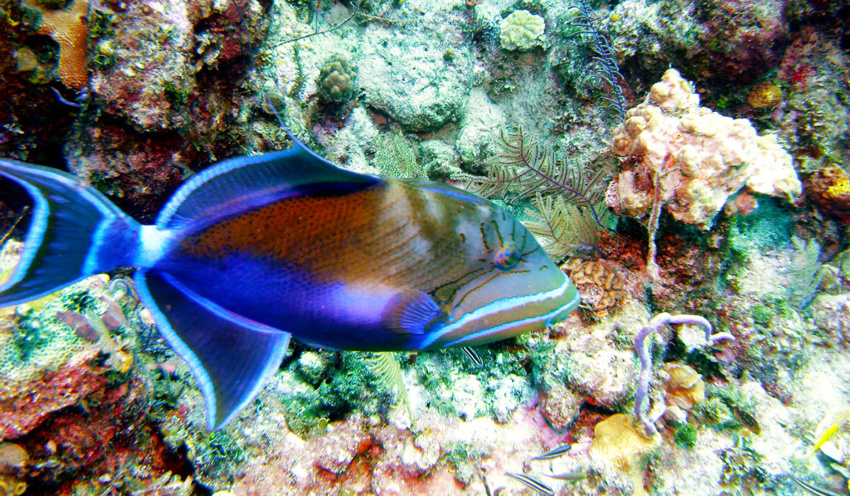
Queen Triggerfish. Fhoto by Greg Grimes wikipedia.org (CC BY-SA 2.0)
The queen triggerfish reaches 60 cm, though most only are about half that length. It is typically blue, purple, turquoise and green with a yellowish throat, and light blue lines on the fins and head. It can change colour somewhat to match its surroundings, or if subjected to stress.
In the western Atlantic, it ranges from Canada to southern Brazil, and in the eastern Atlantic it is found at Ascension, Cape Verde, Azores and south to Angola. It is reasonably common in Florida, the Bahamas and the Caribbean. The queen triggerfish is typically found at coral and rocky reefs in depths of 3–30 m, but it can occur as deep as 275 m and sometimes over areas with sand or seagrass. It preys on a variety of invertebrates, notably sea urchins.
As one of the largest and most aggressive of the triggerfish, this fish is rarely a good choice as a resident in a marine aquarium. It is however a hardy fish for those who can provide it with a proper environment. Because it grows so large and so quickly the minimum aquarium for this fish is a 500-gallon aquarium.
Although some sources argue it can be kept in as little a tank as 125 gallons, when it achieves its adult size of two feet it is very unlikely to thrive, and will likely lead to premature death. Its diet consists of invertebrates. In aquariums shrimp, squid, clams, octopus, scallops, and crab are all good choices of food.
Source: wikipedia.org – Balistes vetula
Glasseyes or Glass Bigeyes (Heteropriacanthus)
Glasseyes or glass bigeyes (Heteropriacanthus) are a genus of the bigeye family found in all tropical seas around the world. It occasionally makes its way into the aquarium trade. It grows to a size of 50.7 cm in total length.
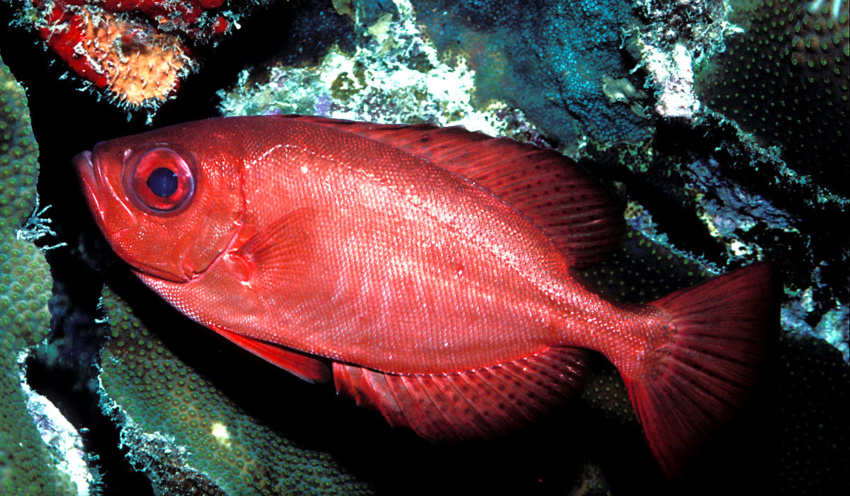
Glasseyes fish. Fhoto by Laszlo Ilyes wikipedia.org (CC BY 2.0)
All glasseyes used to classified in a single species, Heteropriacanthus cruentatus, but recent morphological and genetic analysis indicates that glasseyes should be divided into three species: Heteropriacanthus cruentatus (Atlantic Ocean and southwest Indian Ocean), H. fulgens (northeastern Atlantic), and H. carolinus (Indo-Pacific) [Source].
Circumglobal in tropical and tropically influenced seas. Western Atlantic: continental waters from off Florida to Flower Garden Reef off Texas in the Gulf of Mexico; Caribbean islands and along the coast of South America to Argentina. Eastern Atlantic: eastern and mid Atlantic islands from Madeira to St. Helena; not recorded from African continental waters. Indo-Pacific: South and eastern Africa (excluding the Red Sea) eastward in island habitats through the central Pacific. Eastern Pacific: island habitats from off Baja California to the Galapagos; probably uncommon along coast of Mexico, Central and South America, questionably to Chile [Source].
Whitespotted Filefish (Cantherhines Macrocerus)
Cantherhines macrocerus, commonly known as the whitespotted filefish or American whitespotted filefish, is a marine fish found along the coast of Florida extending southward into the Caribbean. This species is distinct and separate from Cantherhines dumerilii, the similarly named whitespotted filefish which is found in the Indian and Pacific oceans.
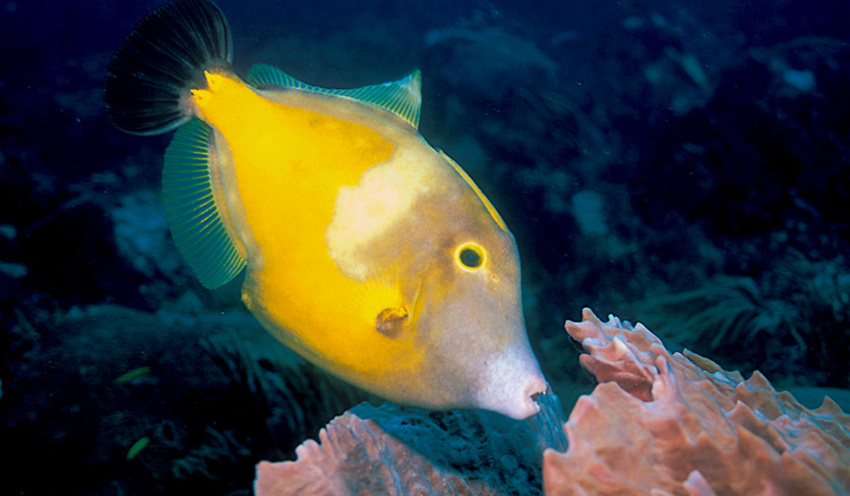
Whitespotted Filefish. Fhoto by Laszlo Ilyes wikipedia.org (CC BY 2.0)
The American whitespotted filefish typically has a brown or olive colored body, although it may also be grey. These fish can rapidly change appearance to a high contrast color pattern with a much darker background and many light colored spots With a maximum length of around 18 inches, they are smaller than the scrawled filefish which is also found in their range. The American whitespotted filefish is often seen in pairs.
These fish are omnivorous; although they eat animals like sponges, stinging coral and gorgonians, and algae. The American whitespotted filefish can be kept in large aquariums. These fish are non-aggressive, need plenty of places to hide, and will eat brine shrimp, krill and algae.
Source: wikipedia.org – Cantherhines Macrocerus
Spotted goatfish (Pseudupeneus maculatus)
Inhabits shallow waters to depths of 90 m, especially over sand and rock bottoms in reef areas. Feed on small invertebrates. Young juveniles often found on beds of sea grass. At cleaning stations, these goatfish often queue up to let themselves be cleaned by cleanerfish or shrimps. The fish that is being cleaned shows a deep red color, while the other waiting show their normal pale pink color. When cleaned they assumed their normal pale pink color again. Probably this change of color serves as a signal to the cleaners to the cleaners when they can start and should stop again.
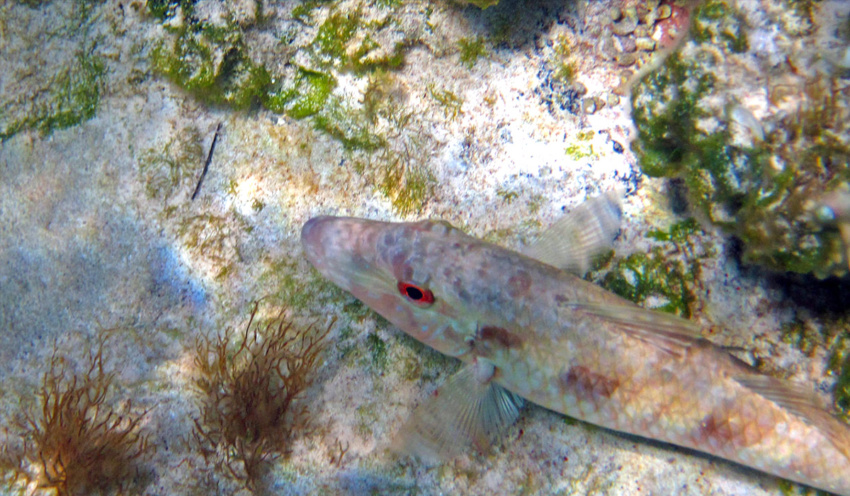
Spotted goatfish. Fhoto by James St. John wikipedia.org (CC BY 2.0)
Body with a series of three large blackish blotches on the upper side, beneath the dorsal fins. Color variable but usually pale, the scales of the back with reddish or yellowish brown edges and a central pale blue spot. Head with diagonal blue lines. Two barbels under the tip of the chin. Size up to 30 cm.
Source: species-identification.org – Spotted goatfish
Yellow Goatfish (Mulloidichthys Martinicus)
The yellow goatfish (Mulloidichthys martinicus), also known as yellowsaddle, is a species of goatfish native to the Atlantic Ocean around the coasts of Africa and the Americas. This species can reach a length of 39.4 centimetres (15.5 in) TL, but most reach lengths only around 28 centimetres (11 in). They are of minor importance to local commercial fisheries, even though they have been reported to carry the ciguatera toxin.
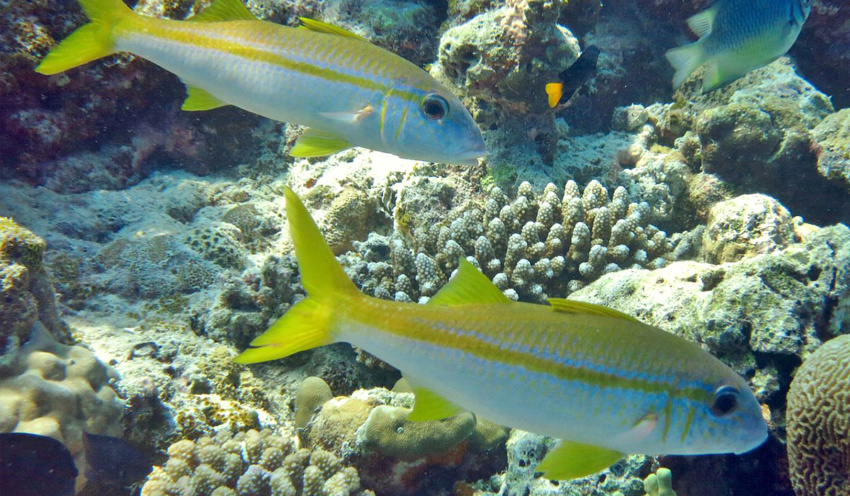
Spotted goatfish. Fhoto by Ahmed Abdul Rahman wikipedia.org (CC BY-SA 4.0)
Yellow goatfish are benthic feeders, using a pair of long chemosensory barbels (“whiskers”) protruding from their chins to rifle through the sediments in search of a meal. They usually feed on smaller fish, hunting in a school during the day, and alone at night. Yellow goatfish can live solitary or in similar-sized groups, sometimes switching between groups. When hunting in groups, each goatfish can be either a chaser, directly attacking prey or as a blocker, surrounding prey hiding in coral.
The yellow goatfish can be found on reefs in the tropical waters in the Atlantic around the United States, in the Gulf of Mexico, the Caribbean Sea, and around Cape Verde.
Source: wikipedia.org – Yellow Goatfish
Bermuda chub (Kyphosus sectatrix)
The Bermuda chub, Kyphosus sectatrix, a sea chub of the genus Kyphosus, is found in the Caribbean and off Florida, Bahamas, Bermuda, and in the Gulf of Mexico along coral reefs and walls. Its length is between 1 and 2 feet on average, with a maximum of 2.5 feet. It was first described by Carl Linnaeus in 1766 [Source].
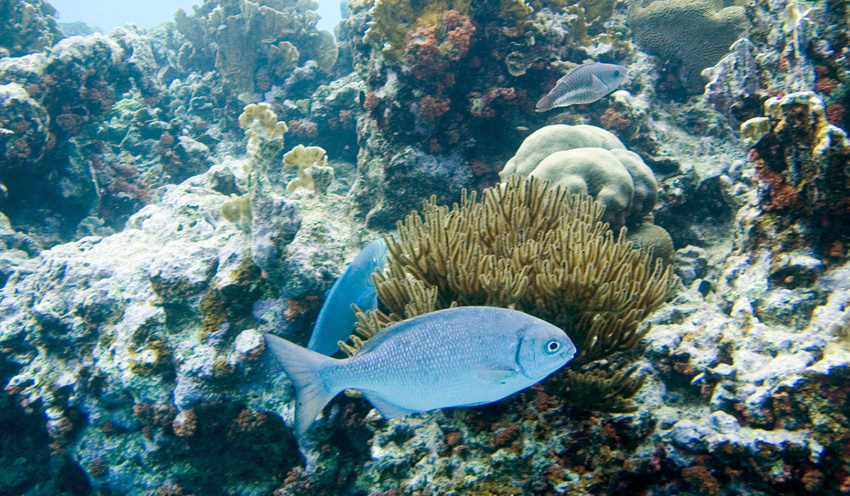
Bermuda chub. Fhoto by Paul Asman and Jill Lenoble wikipedia.org (CC BY 2.0)
Inhabits shallow waters, over turtle grass, sand or rocky bottom and around coral reefs. Young commonly found among floating Sargassum seaweeds. Feeds on plants, mainly on benthic algae, as well as on small crabs and mollusks. Also feeds on spinner dolphins’ feces and vomits at Fernando de Noronha Archipelago, southeast Atlantic. The offal feeding may be regarded as a simple behavioral shift from plankton feeding to drifting offal picking [Source].
